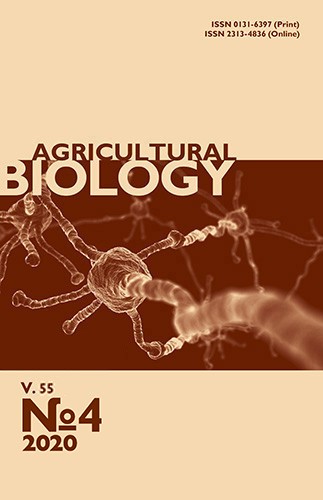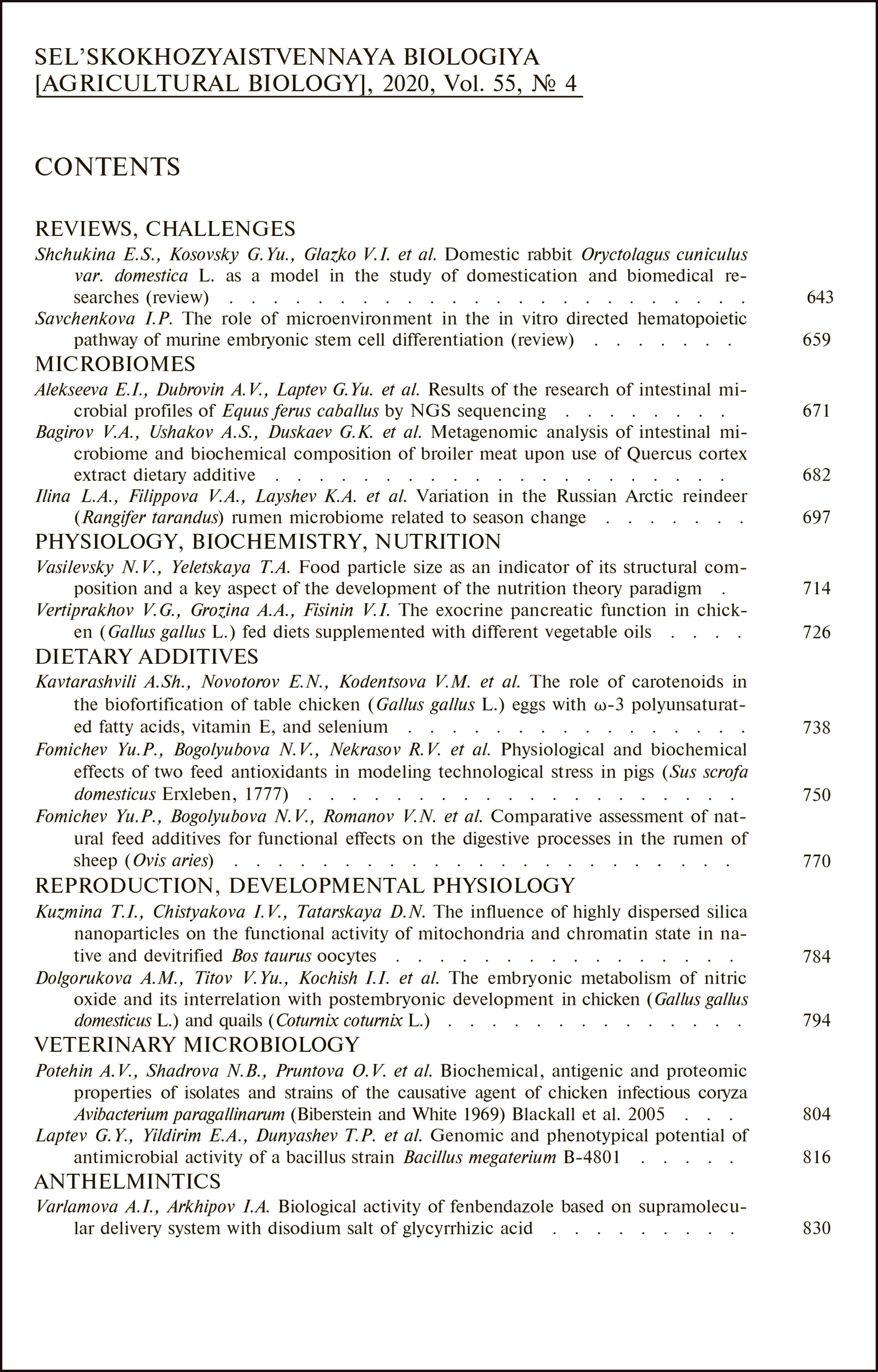doi: 10.15389/agrobiology.2020.4.726eng
UDC: 636.52/.58:591.132:611.37:57.089.6
Acknowledgements:
Supported financially from a subprogram “Study of adaptation mechanisms of the digestive system of mammals and poultry to diets with various ingredients” of the Program for Basic Research (Resolution of the Presidium RAS No. 132 dated 07/05/2017)
THE EXOCRINE PANCREATIC FUNCTION IN CHICKEN(Gallus gallus L.) FED DIETS SUPPLEMENTED WITH DIFFERENT VEGETABLE OILS
V.G. Vertiprakhov, A.A. Grozina, V.I. Fisinin
Federal Scientific Center All-Russian Research and Technological Poultry Institute RAS, 10, ul. Ptitsegradskaya, Sergiev Posad, Moscow Province, 141311 Russia, e-mail Vertiprakhov63@mail.ru (✉ corresponding author), Alena_fisinina@mail.ru, olga@vnitip.ru
ORCID:
Vertiprakhov V.G. orcid.org/0000-0002-3240-7636
Fisinin V.I. orcid.org/0000-0003-0081-6336
Grozina A.A. orcid.org/0000-0001-9654-7710
Received September 19, 2019
The efficiency of different vegetable oils in poultry nutrition is still a matter of interest for the theory and practice; numerous studies in broilers have evidenced that different oils can significantly affect the productive performance and metabolism. However, the mechanism of the influence of different oils on the exocrine pancreatic function is understudied. In our study on fistulated chicken the innovative data are presented for the analysis of the effects of different dietary lipid sources on the secretion and enzymatic activities of pancreatic juice. The study was performed in 2019 on three laying hens (Gallus gallus L., cross Hisex White) with chronic fistulae of main pancreatic duct inserted by the method of Ts.Zh. Batoev (2001). The physiological trials were performed by the method of periods (7-10 days per period): during the control period the basic feed (commercial compound feed for layers PK-1) was supplemented with sunflower oil; during period 1 with soybean oil; during period 2 rapeseed oil; during period 3 flaxseed oil. The pancreatic juice and blood were sampled throughout these periods. The secretion rate of pancreatic juice and enzymatic activities in it (amylase, lipase, total proteases TP, alkaline phosphatase AP) were determined by standard methods. The activities of amylase, lipase, alanine (ALT) and aspartate (AST) transaminases in blood serum were determined on analyzer ChemWell 2900 (T) (Awareness Technology, USA) with corresponding reagent kits by Human GmbH, Germany; the activities of TP and AP and other biochemical indices in blood serum were determined on semi-automatic analyzer Sinnowa BS-3000P (SINNOWA Medical Science & Technology Co., China) with BAPNA as the substrate (TP) and corresponding reagent kits by DIAKON-VET, Russia (AP and all other indices). It was found that the activity of lipase in pancreatic juice can adjust to the dietary oil used. The significantly highest lipase activity was found with unrefined sunflower oil (21345±652.8 μmol·l-1·min-1, p < 0.05), together with the increases in the activity of amylase (9254±440.3 mg·ml-1·min-1, p < 0.05). The increases in lipolitic activity in the first few postprandial minutes (corresponding to complex-reflex phase of regulation of the pancreatic secretion) with sunflower and flaxseed oils evidenced that these oils are the most palatable for chicken while the increase in the activity of lipase in neurohumoral phase of regulation with rapeseed and soybean oils evidenced their higher nutritive value. The strong negative correlation (r = -0.87, p < 0.05) was also found between the activities of TP and AP in the pancreatic juice. The phosphatase-protease index, AP/TP ratio, is proposed as a significant physiological indicator of the adaptation of the digestive tract in poultry to the changes in diet composition. The most affected by oil type blood indices were the activities of TP, lipase, ALT, AST, and concentration of triglycerides. The dynamics of lipase activity in blood serum was similar to that in the pancreatic juice; the AP/TP ratio in serum was partially close to the values of this ratio in the pancreatic juice. The changes found in the exocrine pancreatic function in response to different dietary oils evidenced that the studies on the digestion should be continued for further optimization of the composition of commercial diets for poultry.
Keywords: exocrine pancreatic function, chickens, digestive enzymes in blood, sunflower oil, soybean oil, rapeseed oil, flaxseed oil.
REFERENCES
- Perepelkina L.I., Berdnikov P.P., Samsonenko I.A. Vestnik Altaiskogo agrarnogo universiteta, 2012, 7(93): 67-68 (in Russ.).
- Batoev Ts.Zh. Fiziologiya pishchevareniya ptits [Physiology of digestion in birds]. Ulan-Ude, 2001 (in Russ.).
- Selina T.V. Ptitsevodstvo, 2015, 7: 43-46 (in Russ.).
- Mal'tseva N.A., Yadrishchenskaya O.A., Selina T.V. Ptitsevodstvo, 2016, 7: 11-13 (in Russ.).
- Baião N.C., Lara L.J.C. Oil and fat in broiler nutrition. Brazilian Journal of Poultry Science, 2005, 7(3): 129-141 CrossRef
- Gaganov A.P., Zverkova Z.N., Osipyan B.A. Vysokokontsentrirovannyi istochnik energii dlya broilerov. Adaptivnoe kormoproizvodstvo, 2019, 4: 36-47 CrossRef
- Abbasi M.A., Ghazanfari S., Sharifi S.D., Ahmadi Gavlighi H. Influence of dietary plant fats and antioxidant supplementations on performance, apparent metabolizable energy and protein digestibility, lipid oxidation and fatty acid composition of meat in broiler chicken. Veterinary Medicine and Science, 2020, 6(1): 54-68 CrossRef
- Skřivan M., Marounek M., Englmaierová M., Čermák L., Vlčková J., Skřivanová E. Effect of dietary fat type on intestinal digestibility of fatty acids, fatty acid profiles of breast meat and abdominal fat, and mRNA expression of lipid-related genes in broiler chickens. PLoS ONE, 2018, 13(4): e0196035 CrossRef
- Ye Z., Cao C., Li R., Cao P., Li Q., Liu Y. Lipid composition modulates the intestine digestion rate and serum lipid status of different edible oils: a combination of in vitro and in vivo studies. Food & Function, 2019, 10(3): 1490-1503 CrossRef
- Kowalik B., Majewska M.P., Miltko R., Bełżecki G. The effect of supplementing sheep with rapeseed and linseed oils on the activity of pancreatic digestive enzymes. Journal of Animal Physiology and Animal Nutrition, 2018, 102(5): 1194-1198 CrossRef
- Vertiprakhov V.G., Egorov I.A. The influence of feed intake and conditioned reflex on exocrine pancreatic function in broiler chicks. Open Journal of Animal Sciences, 2016, 6(4): 298-303 CrossRef
- Rukovodstvo po optimizatsii retseptov kombikormov dlya sel'skokhozyaistvennoi ptitsy /Pod redaktsiei V.I. Fisinina [Mixed feed optimization for for poultry — guidelines. V.I. Fisinin (ed.)]. Sergiev Posad, 2014: 3-4 (in Russ.).
- Vertiprakhov V.G., Grozina A.A. Veterinariya, 2018, 12: 51-54 CrossRef (in Russ.).
- Aliev A.A. Progress in digestion physiology of agricultural animals at the twentieth century (principal conception). Sel'skokhozyaistvennaya biologiya [Agricultural Biology], 2007, 2: 12-23 (in Russ.).
- Fisinin V.I., Vertiprakhov V.G., Grozina A.A. The exocrine pancreatic function in chicken (Gallus gallus L.) fed diets containing different ingredients. Agricultural Biology[Sel'skokhozyaistvennaya biologiya], 2018, 53(4): 811-819 CrossRef
- Vertiprakhov V.G., Kislova I.V. Mezhdunarodnyi vestnik veterinarii, 2019, 4: 118-124 (in Russ.).
- Konuskan D.B., Arslan M., Oksuz A. Physicochemical properties of cold pressed sunflower, peanut, rapeseed, mustard and olive oils grown in the Eastern Mediterranean region. Saudi Journal Biological Sciences, 2019, 26(2): 340-344 CrossRef
- Arkhipov A.V. Lipidnoe pitanie, produktivnost' ptitsy i kachestvo produktov ptitsevodstva [Lipid nutrition, poultry productivity and quality of poultry products]. Moscow, 2007 (in Russ.).
- Hu X.Q., Wang W.B., Liu L., Wang C., Feng W., Luo Q.P., Han R., Wang X.D. Effects of fat type and emulsifier in feed on growth performance, slaughter traits, and lipid metabolism of Cherry Valley ducks. Poultry Science, 2019, 98(11): 5759-5766 CrossRef
- Andrianova E.N., Egorov I.A., Prisyazhnaya L.M., Grigor'eva E.N., Rebrakova T.M. Ptitsa i ptitseprodukty, 2016, 2: 39-41 (in Russ.).
- Metreveli T.V. Biokhimiya zhivotnykh /Pod redaktsiei N.S. Sheveleva [Animal biochemistry]. St. Petersburg, 2005 (in Russ.).
- Lai W., Huang W., Dong B., Cao A., Zhang W., Li J., Wu H., Zhang L. Effects of dietary supplemental bile acids on performance, carcass characteristics, serum lipid metabolites and intestinal enzyme activities of broiler chickens. Poultry Science, 2018, 97(1): 196-202 CrossRef
- Kletikova L.V. Mezhdunarodnyi zhurnal prikladnykh i fundamental'nykh issledovanii, 2014, 1: 57-58 (in Russ.).
- Lazareva N.Yu. Ptitsevodstvo, 2019, 2: 37-40 (in Russ.).
- Barshan S., Khalaji S., Hedayati M., Yari M. Influence of bone meal degelatinisation and calcium source and particle size on broiler performance, bone characteristics and digestive and plasma alkaline phosphatase activity. British Poultry Science, 2019, 60(3): 297-308 CrossRef
- Gu Z., Mu H., Shen H., Deng K., Liu D., Yang M., Zhang Y., Zhang W., Mai K. High level of dietary soybean oil affects the glucose and lipid metabolism in large yellow croaker Larimichthys crocea through the insulin-mediated PI3K/AKT signaling pathway. Comparative Biochemistry and Physiology Part B: Biochemistry and Molecular Biology, 2019, 231: 34-41 CrossRef
- Muralidharan J., Galiè S., Hernández-Alonso P., Bulló M., Salas-Salvadó J. Plant-based fat, dietary patterns rich in vegetable fat and gut microbiota modulation. Frontiers in Nutrition, 2019, 6: 157 CrossRef
- Pi Y., Ma L., Pierce K.M., Wang H.R., Xu J.C., Bu D.P. Rubber seed oil and flaxseed oil supplementation alter digestion, ruminal fermentation and rumen fatty acid profile of dairy cows. Animal, 2019, 13(12): 2811-2820 CrossRef
- Castro T., Martinez D., Isabel B., Cabezas A., Jimeno V. Vegetable oils rich in polyunsaturated fatty acids supplementation of dairy cows' diets: effects on productive and reproductive performance. Animals (Basel), 2019, 9(5): 2-16 CrossRef
- Atefi M., Pishdad G.R., Faghih S. The effects of canola and olive oils on insulin resistance, inflammation and oxidative stress in women with type 2 diabetes: a randomized and controlled trial. Journal of Diabetes & Metabolic Disorders, 2018, 17(2): 85-91 CrossRef
- Zhou Q., Jia X., Yao Y.Z., Wang B., Wei C.Q., Zhang M., Huang F. Characterization of the aroma-active compounds in commercial fragrant rapeseed oils via monolithic material sorptive extraction. Journal of Agricultural and Food Chemistry, 2019, 67(41): 11454-11463 CrossRef
- Salles M.S.V., D’Abreu L.F., Júnior L.C.R., César M.C., Guimarães J.G.L., Segura J.G., Rodrigues C., Zanetti M.A., Pfrimer K., Netto A.S. Inclusion of sunflower oil in the bovine diet improves milk nutritional profile. Nutrients, 2019, 11(2): 2-15 CrossRef
- Katan T., Caballero-Solares A., Taylor R.G., Rise M.L., Parrish C.C. Effect of plant-based diets with varying ratios of ω 6 to ω3 fatty acids on growth performance, tissue composition, fatty acid biosynthesis and lipid-related gene expression in Atlantic salmon (Salmo salar). Comparative Biochemistry and Physiology Part D: Genomics and Proteomics, 2019, 30: 290-304 CrossRef
- Dong X.F., Liu S., Tong J.M. Comparative effect of dietary soybean oil, fish oil, and coconut oil on performance, egg quality and some blood parameters in laying hens. Poultry Science, 2018, 97(7): 2460-2472 CrossRef












